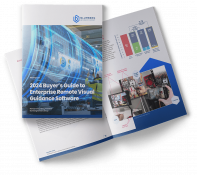Help Lightning Blog
Using RVA to Make Machine Downtime More Efficient

Machine downtime – planned and unplanned – is a major pain point that Original Equipment Manufacturers (OEMs) are constantly seeking to mitigate. Unplanned downtime is especially challenging; it results in lost revenue, unhappy customers, and wasted man hours. As mobile technology, AI, the Internet of Things (IoT), and Augmented Reality (AR) become more ubiquitous across the manufacturing industry, many OEMs eagerly look toward these advances in hopes of making downtime as efficient as possible – and possibly eliminating it altogether.
Our team collaborated with Blumberg Advisory Group on a comprehensive guide on understanding and reducing the cost of downtime: Remote Visual Assistance: The Optimal Last Mile Support Tool for Reducing the Cost of Downtime. This guide is a free resource that explains the costs of downtime alongside how companies can leverage Remove Visual Assistance (RVA) to make the entire process more efficient and reduce costs.
Help Lightning customers report improved efficiency in planned and unplanned downtime. They also note a reduction in unexpected problems. Problems that arise can be resolved faster.
This article unpacks exactly how our AR-enabled software enables our manufacturing clients to transform a once cumbersome process into one of greater ease and efficiency.
What’s the True Cost of Manufacturing Downtime?
The true cost of downtime ranges and is company specific, but wasted resources and revenue occur across the board. This is especially true for unplanned downtime. In fact, a recent study by IndustryWeek in collaboration with Emerson, found that unplanned downtime costs industrial manufacturers an estimated $50 billion annually.
Our guide Remote Visual Assistance: The Optimal Last Mile Support Tool for Reducing the Cost of Downtime, provides a detailed breakdown of how companies can determine their cost of downtime. Downtime costs are a function of an asset’s value-in-use. Lost revenue is a given; however, there are eight additional inputs companies must consider. This includes:
- Detection Costs (Dc)
- Containment Costs (Cc)
- Recovery Costs (Rc)
- Ex-post Response Costs (Epc)
- Equipment Cost (Ec)
- IT Productivity Loss (ITpl)
- User Productivity Loss (Upl)
- Third-Party Costs (Tpc)
Tracking these metrics is essential for companies to understand the real consequences of downtime. Once these costs are understood, these metrics can be measured for improvement when implementing RVA.
Use RVA to Make Downtime More Efficient – Or Prevent it Altogether
Whether planned or unplanned, manufacturing companies’ objective with downtime is to avoid it when possible, and make it efficient when it’s necessary. While many technologies show promise in reducing or eliminating manufacturing downtime, RVA is one of the most cost-effective and easiest to implement.
RVA enables companies to reduce, and potentially eliminate, unplanned downtime. AR-enabled video streaming, via mobile or desktop, allows users on both sides of the screen to dynamically engage with each other’s view, from anywhere in the world. This replicates the experience of being in the same physical space and working together on equipment as if side-by-side.
For example, reaching into each other’s screen to point to a part or component, making annotations right onto a shared view, incorporating tools to demonstrate a complex function, freezing a frame for a more granular view, and visually collaborating in ways that are entirely unique to your specific use case.
Here’s how these features translate to optimizing downtime – or preventing it altogether. Help Lightning enables remote technicians to be ‘onsite’ without having to travel to the manufacturing facility. The reduced need for travel time and ability to easily include expert technicians in preventative maintenance or planned downtime reduces friction caused by having to coordinate multiple schedules and cancel plans if travel problems occur.
Additionally, onsite technicians can be trained in proactive maintenance, with oversight from remote expert technicians. Plant managers, foremen, and technicians can consistently review a range of operations. They can easily learn to audit equipment and engage expert technicians in regular check-ins to ensure all equipment is operating optimally. This includes consistent inspections of hardware and software, as well as performance reviews and training for equipment operators.
RVA can also be used to improve other metrics, including reduced First Time Fix Rate, Service Level Agreement, Mean Time Between Failure, and more.
Our whitepaper Remote Visual Assistance: The Optimal Last Mile Support Tool for Reducing the Cost of Downtime, goes into greater detail on this. This includes the ability to anticipate problems before they occur, and how to calculate the true costs of downtime.
Get Instant Access to Help Lightning’s Guide on Reducing the Cost of Manufacturing Downtime
Our guide is now available for download: Remote Visual Assistance: The Optimal Last Mile Support Tool for Reducing the Cost of Downtime. It discusses the types of downtime, goes into the specific consequences of downtime, provides information on calculating your company’s cost of downtime, and how to reduce – and even prevent – planned and unplanned downtime.
This is a must-have guide for manufacturing, energy, and service companies aiming to optimize operations for profitability, productivity, and overall customer experience.












